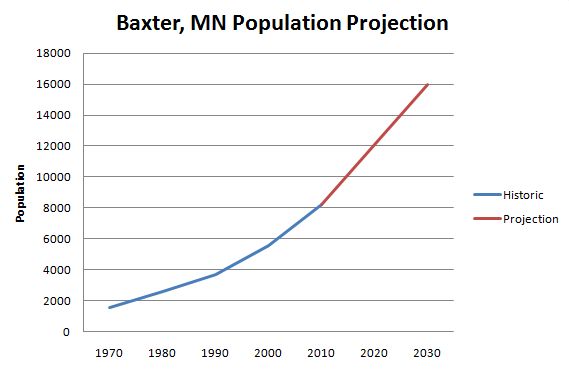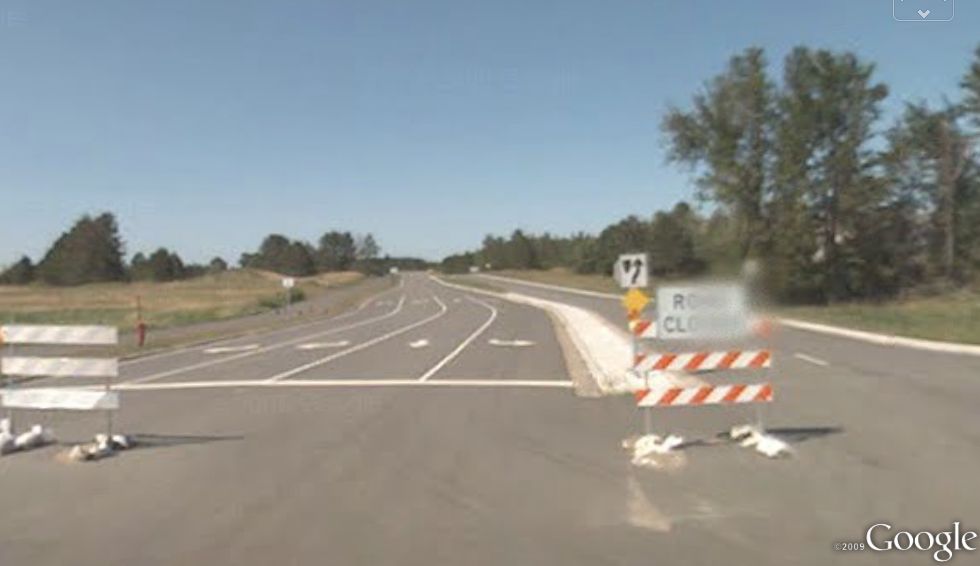Baxter Happy Motoring
(This posting is another in our Brainerd/Baxter Strong Town series, which focuses on land use practices in my neighboring hometowns. In doing so, we are seeking to highlight problems with the current approach towns take to growth and development and provide real-world strategies for growing Strong Towns. If you have not read the kickoff article for this series, I would recommend it before reading this post. You can also read other posts in this series by clicking here.)
I'm going to borrow James Kunstler's term "happy motoring" for this posting today because I can't think of a better description for what is going on in Baxter, one of my twin hometowns here in Central Minnesota. They are the topic of this post because of a recent article in the local paper, an article that began with this:
The city of Baxter's population is projected to double by 2030, from 8,200 residents to more than 16,000 residents, says Mayor Darrel Olson.
And those new residents will drive cars. Lots of cars.
Baxter is the perfect case study of the suburban development model. Prior to WW II and the motoring age, Baxter was a collection of farms and lake cabins connected by old, country roads. It was a sleepy place on the outskirts of Brainerd, which was the county seat and the major urban center. It stayed this way for decades, growing slowly, until things picked up in the mid-1980's and continued through the recent growth era.
There are two reasons I would call Baxter the perfect case study for suburban development. First, they had very little pre-suburban residue when their current growth pattern started. They had no historic downtown. No significant infrastructure of a different age. Their development pattern has been pure suburban in nature.
Second, they have been expert about assembling this development pattern. These people are imminently competent. They have "planned" ahead, inasmuch as the standard suburban model would have a community anticipate. They have oversized pipes and roads and strategically located major infrastructure improvements so as to be ready for the growth they knew was coming. Unlike many Sim-communities of the recent past, there is very little in Baxter that has needed to be redone.
If Baxter ultimately winds up failing or in serious decline, it will not be because they had some albatross they could not overcome or because they acted incompetently. It will be because the model doesn't work.
There are plenty of great books about why the suburban development model does not work, the best among them being Suburban Nation, so this post is not going to go into that. What we are going to look at is the underlying assumption: continued massive growth.
From 1970 through the growth spurt and up to 2010, Baxter has grown from just over 1,550 people to an estimated 8,200. That is roughly 6,600 additional residents in 40 years. The projection quoted by the mayor in this article is for another 8,000 in the next 20 years. On a graph, it looks something like this:

Let's ask the obvious question. Is this a realistic projection? Sure, if you rely on mathematics and Excel charts. If your understanding is deeper than this, however, you are going to be skeptical.
Look back on the "rapid growth" period for Baxter between the late 1980's and 2007 and consider all of the events that induced growth but are not going to repeat themselves. Here is an abbreviated list:
- In the mid-1980's, a new mall was built on the Brainerd/Baxter boundary, shifting commerce west towards Baxter.
- In the early 1990's, commerce further shifted west with the opening of Wal-Mart, followed shortly by Target and some large grocery stores.
- Mn/DOT constructed the bypass of Brainerd in the mid-1990's, which dramatically increased traffic along the main corridor through Baxter. Further development sprang up along this corridor.
- Construction area-wide boomed, particularly as lake properties were converted from cabins to year-round superhomes. This was done to fill demand from baby-boomers nearing retirement.
- The secondary effects of the construction boom for shoreline properties was a need for housing for those working as the support infrastructure of the construction industry (everything from carpenters to engineers and their families). Baxter, shiny and new, was the natural recipient of much of this growth.
- The tertiary effects of this was more local demand for good and services overall. This spawned everything from new schools to medical centers to a "super" Wal-Mart to replace the old Wal-Mart.
In short, the industries of growth compounded and drove yet more growth in a self-reinforcing cycle. It was kick-started by the redevelopment of shoreline properties and fueled by the same sub-prime mortgages, collateralized debt obligations and other mechanisms of growth we have seen at work elsewhere.
For Baxter, these mechanisms of growth are gone. Baxter has not received a lot of support from the federal and state government, especially compared to neighboring Brainerd, but it has received some. It is difficult to envision large-scale federal and state investment in local governments over the coming two decades, given commitments to social security, health care spending, debt interest and other growing entitlements.
Likewise with Mn/DOT. There is not going to be another large transportation investment in Baxter the size of the Brainerd bypass, even if Mn/DOT had the money (which it does not). The ability to fuel growth by leveraging debt, particularly in the private sector (but likely to be in the public sector soon, too), is waning.
And finally, the Growth Ponzi Scheme is catching up with Baxter. That brand new mall built in the mid-1980's is somewhat of a ghost town. One of the anchors has disappeared and the other has gobbled up a third of the total space, not a successful long-term strategy for a structure designed to be a destination. So the bills are starting to come due, while on the other end of the Ponzi scheme, growth has stopped. There are many, many lots sitting empty, houses in one stage or another of foreclosure and recent large investments in growth have thus far manifested as cruel jokes.
 Image taken from Google Street View
Image taken from Google Street View
So where is the growth they are projecting going to come from? That question is not nearly as important to Baxter officials as it should be. And there are good reasons for that, which I will get into with subsequent posts this week.
And just to reiterate what we always say with posts in this series: I focus on Brainerd and Baxter partly because they are up the road from me and, having grown up there, I know their stories intimately. But primarily, we do this series because Brainerd and Baxter are good examples of what tens of thousands of communities across the country are doing today. They provide a good forum to examine the underlying assumptions of our development model.
Coming Up
Tuesday: Why Baxter NEEDS growth.
Wednesday: The impact of a "happy motoring" mentality.
Thursday: What a different approach would look like.
You can continue this Strong Towns conversation by posting a comment or by joining us on Facebook or Twitter.
